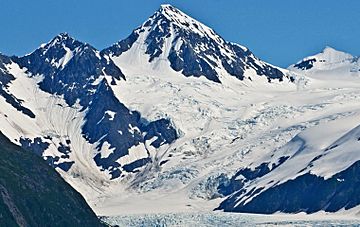Passage Peak facts for kids
Quick facts for kids Passage Peak |
|
|---|---|

Passage Peak and Billings Glacier
|
|
| Highest point | |
| Elevation | 5,990 ft (1,830 m) |
| Prominence | 2,690 ft (820 m) |
| Isolation | 5.2 mi (8.4 km) |
| Geography | |
| Location | Anchorage Borough Alaska, United States |
| Parent range | Chugach Mountains |
| Topo map | USGS Seward D-5 |
Passage Peak is a prominent mountain summit in Alaska, United States. It stands about 5,990-foot (1,826 m) tall. This peak is part of the Chugach Mountains.
You can find Passage Peak inside the Chugach National Forest. It is about 9 mi (14 km) northeast of a town called Whittier, Alaska. The mountain is located where the Chugach Mountains meet the Kenai Mountains. Other nearby peaks include Maynard Mountain and Boggs Peak. They are both about 10 mi (16 km) to the southwest.
Even though it's not the tallest mountain, Passage Peak rises dramatically from the water. Its southern side goes straight up from the tidewater of Prince William Sound's Passage Canal. This happens over a distance of about five miles. The peak gets its name from Passage Canal. Captain George Vancouver named the canal in 1794. He likely named it this way because it led to a path connecting Prince William Sound with Cook Inlet.
Understanding Passage Peak's Climate
Passage Peak is located in a subarctic climate zone. This means it has very long, cold, and snowy winters. The summers are usually mild. The weather systems come from the Gulf of Alaska. When they hit the Chugach Mountains, the air is forced upwards. This process is called orographic lift. It causes a lot of rain and snow to fall on the mountain.
During winter, temperatures can drop very low. They might go below −20 °C. With the wind chill, it can feel even colder, sometimes below −30 °C. This cold climate helps two large glaciers survive. The Billings Glacier is on the south side of the peak. The huge Harriman Glacier covers the north slope.


